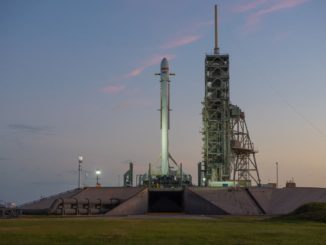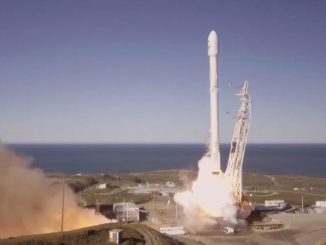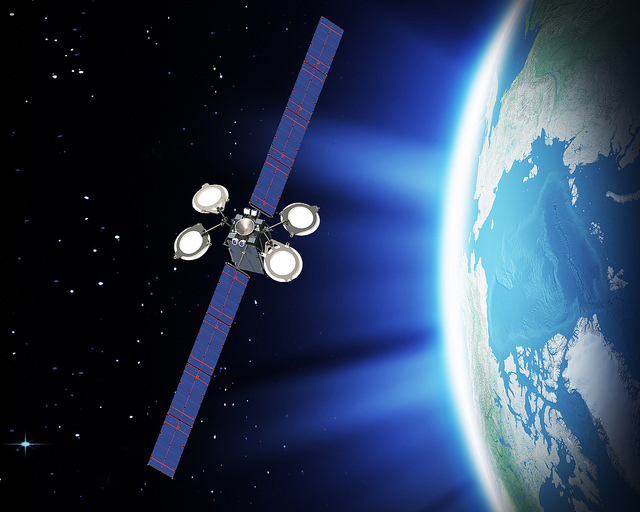
A new class of Boeing-built spacecraft will fly into orbit for the first time Sunday aboard a Falcon 9 rocket, combining Boeing’s electric propulsion technology with SpaceX’s bargain launch prices to send up communications satellites at a fraction of the typical cost.
SpaceX ground teams are preparing for liftoff of the 224-foot-tall Falcon 9 rocket at 10:50 p.m. EST Sunday (0350 GMT Monday) from Cape Canaveral’s Complex 40 launch pad. The launch window extends for 42 minutes, 30 seconds.
The launch will be SpaceX’s third Falcon 9 mission in less than three months, with two more Falcon 9s due for liftoff by mid-April.
The spacecraft mounted on top of the Falcon 9 rocket are owned by Paris-based Eutelsat and Asia Broadcast Satellite headquartered in Bermuda and Hong Kong, ready to begin missions to beam television, multimedia services, Internet traffic and other services across the Americas, Europe, the Middle East and Africa.
Once released from the Falcon 9 rocket, the satellites will employ efficient electrically-powered engines instead of liquid fuel to reach their final operating posts 22,300 miles above the equator.
“So far, everything is going well, and knock on wood if the weather cooperates, we should have a launch on Sunday night,” said Ken Betaharon, chief technology officer at ABS.
The weather forecast calls for a 70 percent chance of favorable conditions, but meteorologists will monitor clouds for possible violations of the Falcon 9 rocket’s weather rules.
The Eutelsat and ABS satellites will launch without a supply of conventional liquid hydrazine fuel, relying entirely on electric ion engines to reshape their orbits and maintain their positions for up to two decades.
The launch marks the debut for a new lightweight satellite bus called the Boeing 702SP, which differs from other communications satellite platforms with the removal of the large fuel tank that forms the core of most spacecraft.
Half of the weight of most communications satellites is taken up with fuel, sometimes carrying up to 5,000 pounds of liquid propellant for in-space maneuvers. The innovation of the Boeing 702SP allows satellite operators to order smaller spacecraft that can host extra communications capacity to replace the mass freed up with the removal of the fuel tanks, said Mark Spiwak, president of Boeing Satellite Systems International Inc.
“One of the big drivers was cost,” Spiwak said. “We’re able to get the launch cost significantly reduced, get more payload mass to orbit, and reduce the overall cycle time of (building each satellite).”
Large satellites built by Boeing and other companies have used electric propulsion before, but the spacecraft have always carried chemical rocket fuel to supplement their ion engines.
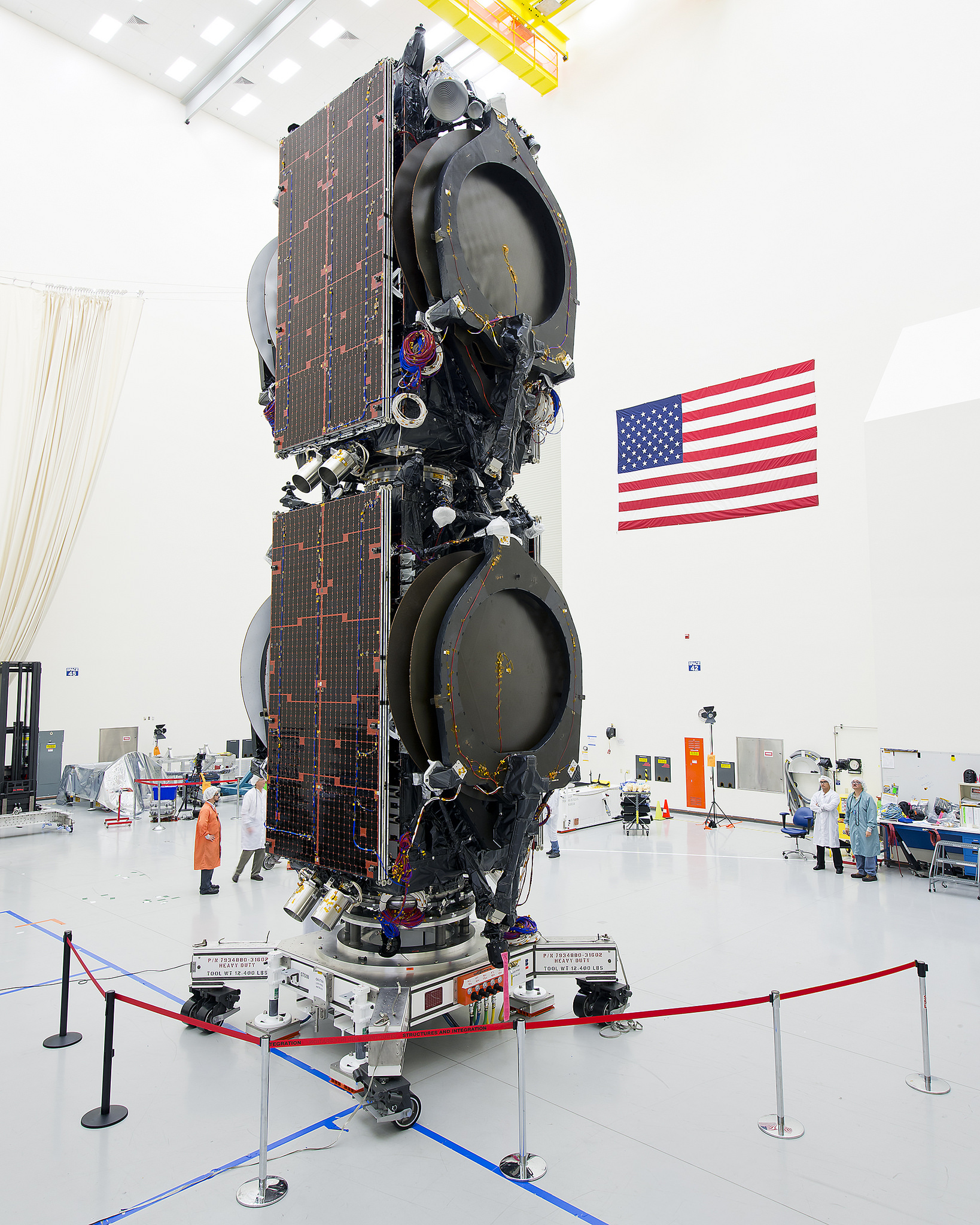
Without the need for liquid fuel, each satellite weighs less than 5,000 pounds. Betaharon said a spacecraft with comparable capabilities would weigh more than 8,000 pounds without the all-electric propulsion system.
With the reduced weight at launch, two lighter payloads can ride into orbit together on SpaceX’s Falcon 9 rocket, which is only powerful enough to loft one large telecommunications satellite at a time.
“The real driver for that lighter solution was to be able to stack two commercial communications satellites on top of each other and provide a dual launch,” said Mike Connelly, director of Boeing’s product line for the new 702SP platform. “When you look at the mass of a satellite, with kind of a classic satellite system, it’s dominated by the fuel load of the direct-to-orbit mission.
“Going to an all-electric system, you’re able to reduce the fuel load by almost a factor of 10,” Connelly said. “That fuel load reduction allowed us to stack the satellites on top of each other, and give the customers a two-for-one deal on the launch costs.”
Eutelsat and ABS paid less than $30 million a piece to launch their satellites on the Falcon 9, officials said.
Such a low price for the launch of a communications satellite is “almost unheard of,” according to Betaharon, a satellite industry veteran with more than 35 years of experience.
The satellites are mated together inside the Falcon 9 rocket’s nose cone with a special mounting fixture patented by Boeing. The payloads connect directly to each other for the launch, and they do not require a special dual-payload adapter system used on other rockets, such as Europe’s Ariane 5 launcher, which is tailored to lift off with two satellites at a time.
The Falcon 9 rocket will blast off and turn due east from Cape Canaveral, racing across the Atlantic Ocean and climbing into the upper atmosphere before its nine-engine first stage switches off about three minutes after liftoff.
The first stage will jettison from the Falcon 9’s second stage and fall back into the Atlantic Ocean. The hefty weight of the Eutelsat and ABS satellites, coupled with the mission’s high-altitude destination, will keep the first stage booster from attempting a flyback maneuver and landing on SpaceX’s recovery barge.
SpaceX’s last two Falcon 9 rockets carried landing legs mounted on the base of the booster, but the launch vehicle for Sunday’s flight will lift off without the recovery systems.
The company is experimenting with the Falcon 9 booster to see if it can be returned to Earth intact for reuse on future missions.
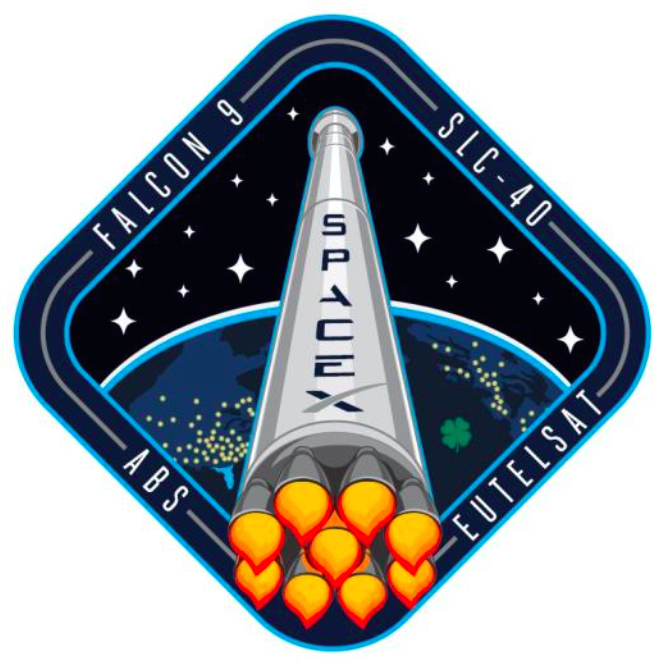
The Merlin 1D engine on the Falcon 9 rocket’s second stage will fire two times, first to reach a temporary parking orbit less than nine minutes after launch. Once it reaches the boundary between Earth’s atmosphere and space, the Falcon 9’s composite payload fairing will release from the nose of the rocket about four minutes into the mission.
After a nearly 17-minute coast, the upper stage’s Merlin engine will fire again for about one minute, then orient itself for deployment of the ABS 3A satellite riding in the upper position on the dual-payload stack.
The Eutelsat craft is programmed to separate about 30 minutes after liftoff, then the Falcon 9 stage will pivot another direction before casting off the Eutelsat 115 West B satellite five minutes later, ensuring the two spacecraft avoid colliding.
The Falcon 9 will send the satellites into an oval-shaped “supersynchronous” transfer orbit with a high point more than 27,000 miles above Earth and a low point about 250 miles up, Betaharon said.
The satellites will extend their electricity-generating solar panels after separation from the launcher to begin charging their batteries and power their ion thrusters.
Then it is up to each spacecraft to raise its orbit and adjust its inclination toward the equator, a job that will take at least six months with all-electric propulsion, rather than a couple of weeks with a conventional rocket engine.
“From an orbit-raising standpoint, the difference between a xenon-ion propulsion orbit-raising and liquid propulsion orbit-raising is really based on the thrust the engines can provide,” Connelly said.
ABS 3A, the lighter of the two satellites, should reach geosynchronous orbit 22,300 miles over the equator by the end of August, Betaharon said. The Eutelsat 115 West B spacecraft will take a few weeks longer because it weighs more — a consequence of the Eutelsat satellite’s assignment to launch in the lower slot on the Falcon 9.
“With the electric thrusters, every increase in mass increases your orbit-raising time because the thrust is extremely low with these thrusters,” Betaharon said.
The lower satellite in the tandem stack is beefier to carry the load of the spacecraft riding on top.
“The advantage you get with xenon-ion is very high ISP (specific impulse, or efficiency), but the consequence is that the thrust is low and it takes longer to get from the transfer orbit to geosynchronous orbit,” Connelly said. “The basic science of the transfer orbit doesn’t change, it’s just the amount of time to get through the orbit-raising period.”
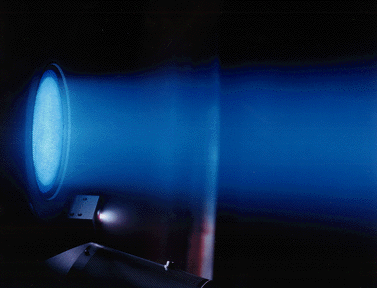
The thrusters are the same as the units flown on previous Boeing satellites, and they work by consuming xenon gas, using electricity to ionize the propellant, the spitting out plasma at high speed. The thrust delivered by the four engines on each satellite is comparable to the pressure exerted by holding a piece of paper, but the upside is the thrusters can fire nearly continuously.
The xenon-ion propulsion system has flown on Boeing satellites since the 1990s, officials said, but the thrusters were previously only used to keep the spacecraft in position in geosynchronous orbit or in conjunction with liquid-fueled jets.
The extended orbit-raising phase will expose the satellites to Earth’s radiation belts for longer periods than usual. Connelly said Boeing engineers analyzed the spacecraft’s resilience to radiation, and added shielding to ensure some components on deployable appendages escape damage.
Connelly said the satellites can accommodate more than 700 pounds of xenon, which was loaded aboard the Eutelsat and ABS spacecraft before they departed Boeing’s factory in El Segundo, California, for the trip to Cape Canaveral.
The design streamlines payload processing at the launch site because the satellites do not have to be fueled with toxic propellant, cutting the time it takes to prepare the spacecraft for liftoff.
The satellites will unfurl their communications antennas while transiting from the Falcon 9’s drop-off orbit to geosynchronous altitude, where their speeds will match the rate of Earth’s rotation, causing the craft to hover over a fixed geographic point.
Then the satellites will begin two-to-four weeks of testing before entering service late this year.
ABS 3A’s destination is at 3 degrees west longitude, blanketing the Americas, Europe, Africa and the Middle East with television programming, Internet services, cellular backhaul, and maritime communications capacity.
“If everything goes well, and we have no issues with the electric thrusters, it should be in orbit and operational around the end of August or the beginning of September timeframe and last for about 22 years,” Betaharon said.
The ABS payload hosts 24 C-band and 24 Ku-band transponders, replacing and extending communications coverage currently provided by the ABS 3 satellite, which launched in 1997 and is nearing the end of its life.
“Virtually every geographic market you can see from that location, we are covering it with C- and Ku-band,” Betaharon said. “Also, the Ku-band beam covering Europe allows us to have a trans-Atlantic coverage from Europe to North America. That can be used for navigation or for other in-flight connections.
“Every service you can imagine that can be provided via satellite can be provided with this one,” Betaharon said. “We’ve got a very high-performance satellite, and the beams are very powerful, and some of the capacity is already spoken for ahead of time.”
The Eutelsat 115 West B satellite will slide into a parking slot at 114.9 degrees west longitude over Latin America.
“The launch of the next-generation Eutelsat 115 West B satellite is a milestone that will position us as a major satellite operator across the continent,” said Patricio Northland, CEO of Eutelsat Americas.” It will transform the 114.9 degrees west orbital position that is already a neighborhood of choice for fast-growing high-speed data and mobility markets in North and South America.”
Eutelsat acquired the spacecraft launching Sunday with the French operator’s purchase of Mexico’s Satmex in 2014. Satmex originally negotiated the satellite’s manufacturing and launch deals with Boeing, SpaceX and ABS in 2012.
“This satellite will address data services, including broadband access, cellular backhaul, VSAT solutions and social connectivity,” said Michel de Rosen, CEO of Eutelsat.
The new satellite — fitted with 34 Ku-band and 12 C-band transponders — will replace a former Satmex spacecraft launched in December 1998 and reach customers in a wide swath of the Americas from Alaska to Patagonia. It also carries an instrument package for the Federal Aviation Administration to improve air navigation over the United States.
Eutelsat says it is the first of five new spacecraft the company expects to launch this year.
For telecom operators, going with an all-electric satellite design is a trade that could make sense for spacecraft on the smaller end of the mass spectrum. For larger satellites with power-hungry communications missions, chemical propulsion is still a viable solution, Spiwak said.
“The economics are quite attractive, but the businesses cases and schedules need to match up regarding mass, payload accommodations and other things,” Spiwak said.
Airbus Defense and Space has unveiled its own all-electric satellite design since Boeing announced its new platform in 2012. Airbus has sold three of its all-electric satellites in the last year, and Spiwak said Boeing has confirmed commercial orders for five all-electric Boeing 702SP satellites, including the spacecraft set for launch Sunday.
Boeing officials also disclosed last year the company had sold three satellites with only electric propulsion to the U.S. government for classified missions.
Eutelsat, ABS, Boeing and SpaceX are teaming up for a nearly identical launch of two more satellites on a Falcon 9 rocket before the end of 2015.
The other all-electric satellites being built by Boeing have not been assigned to a launch vehicle. One of the new-design Airbus satellites with a plasma propulsion system will launch on a SpaceX Falcon 9 rocket, and the other two are contracted to lift off on Ariane 5 rockets in 2017.
“We’re on contract for these first ones with SpaceX, but different launch vehicle providers are looking at how to accommodate the stacks,” Spiwak said, adding the platform is compatible with the Ariane 5, Proton, Falcon 9, Atlas 5 and Delta 4 rockets.
“We’re not married to SpaceX,” Spiwak said. “It fits very well on the SpaceX Falcon 9, and there’s some great economics associated with that. But we can launch on any launch vehicle that the customer is able to procure or if they want us to procure it, we’ll go after that and see what fits.”
Follow Stephen Clark on Twitter: @StephenClark1.

